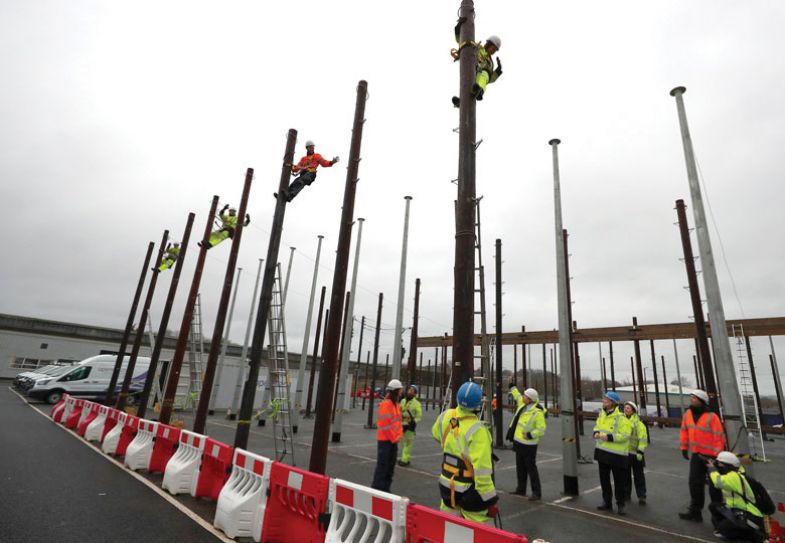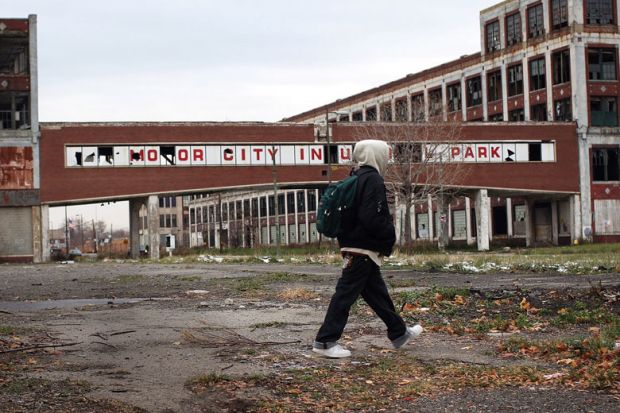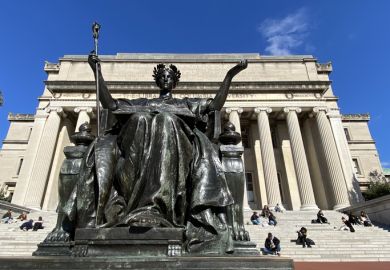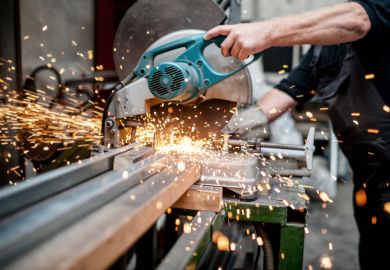More than a decade ago, the former Chicago Tribune journalist Richard Longworth was travelling through the US Midwest for a book about the impact of globalisation on its economy when he reached Dayton, Ohio.
In Dayton, a city reeling from the collapse of the US auto industry, Longworth was startled to hear a union official tell him that Lyndon LaRouche, “the conspiracy theorist and perennial presidential candidate”, was gaining support among disaffected workers.
Longworth’s book, Caught in the Middle: America’s Heartland in the Age of Globalism, was published in 2008, the year Barack Obama was first elected – a time when Donald Trump was still in charge of judging which celebrity on The Apprentice had fared worst in creating a new kind of sandwich. Yet the mood in Dayton prompted Longworth into a prescient reflection. “Globalization is made to order for demagogues and conspiracy theorists…it exposes the vulnerable to distant and mysterious forces,” he wrote. “It enriches a new class of global citizens, but undermines a way of life for middle-class workers who can’t understand what is happening to them and don’t feel they deserve it.”
A backlash as these workers sought someone to blame was “likely”, Longworth warned, “unless the cities and regions where these workers live can find new ways to earn their living and support these people.”
Since 2008, the legacy of the Midwest’s dramatic, traumatic deindustrialisation has created an electoral knife-edge that reshaped politics for the US – and the world – via the rise of Trump. Joe Biden confined Trump to a single term by winning back three traditionally Democratic “Rust Belt” states that were crucial in giving the outgoing president his stunning victory in 2016: Michigan, Wisconsin and Pennsylvania.
Not surprisingly, the Biden campaign’s economic plan acknowledged heartland areas in its aim to “create millions of new manufacturing and innovation jobs throughout all of America”. The plan includes pledges for “a new $300 billion investment” in R&D and breakthrough technologies, plus an expansion of “manufacturing innovation partnerships” by enhancing efforts to “connect research universities…community colleges, manufacturing institutes, and employers, unions, and state, local, and tribal governments”.
Given the scale of challenge in the Midwest and the election-tipping role of its politics, the success or failure of Biden’s economic plan in that region is likely to be hugely consequential. And the pandemic only makes the challenge even bigger, given that the health and economic impacts of Covid have been more severe in the Midwest than in most other US regions.
Some in the Midwest believe that the area's research universities are its biggest potential strength – and central to the hope of creating new jobs. Ideas for how those universities can punch harder economically by collaborating, rather than just competing, across state lines are beginning to emerge into reality.
The question – acutely relevant beyond the Midwest, too – is whether research and innovation spending centred on universities can translate into jobs for all sections of society: whether it can spread benefits beyond university cities and begin to bridge the US’ urban-rural chasm. As Timothy Killeen, president of the University of Illinois System, puts it: “The world needs a new model of innovation that doesn’t just create [social] gaps; we need to be able to lift society up.”

The precise extent of the Midwest is a vexed question, but it can be defined as reaching from the Appalachian foothills in the east and the Great Lakes in the north to the shores of the Missouri river in the west and south. And if there is a common identity across the states of Ohio, Michigan, Indiana, Illinois, Wisconsin, Minnesota, Iowa, Missouri, plus western Pennsylvania, it stems from having been the motor of America’s economy through the 20th century.
Steel and auto were truly regional industries, with their huge demand for parts creating supply chains and smaller factories that were the entire foundation of many Midwestern towns. These industries were “locomotives that pulled the whole region behind them”, says Longworth, who is now a distinguished fellow on global cities at the Chicago Council on Global Affairs thinktank. Manufacturing work was often grim, but in the post-war era it made secure, well-paid, unionised jobs available to people with no higher qualification than high school diplomas.
Hence, when that locomotive hit the buffers, the impact on the regional economy was devastating, from metropolises such as Detroit through smaller cities like Gary, Indiana, or Youngstown, Ohio, to a plethora of smaller manufacturing towns.
The Midwest’s greatest competitive advantage today is that it has “the biggest network of higher education horsepower in the world”, according to John Austin, a non-resident senior fellow at the influential Brookings Institution thinktank, director of the Michigan Economic Center and author of several reports calling for the region’s universities to become its economic motor.
If you set any store by university rankings, the Midwest certainly lines up impressively, with 14 universities inside the top 150 of the Times Higher Education World University Rankings. Many of those are state universities and, in particular, land-grant universities, founded in the 19th century with a particular mission for economic development. And these universities already have huge economic impact. The Midwest is no “monolith of struggling factory towns”, stresses Austin. “The big university towns are thriving…in a global economy. From Madison to Iowa City…they are creating new businesses and jobs, growing new sectors.”
A 2019 report from the Brookings Institution identified potential “growth centres” (based on metrics such as innovation jobs growth, numbers of patents filed and proportion of the population with degrees) across the US “heartland”, which could be developed through extra federal research investment. Number one on the list was Madison, home to the University of Wisconsin-Madison, followed by Minneapolis-St Paul, home to the University of Minnesota. The report calls on the federal government to run a contest to select between eight and 10 such centres for funding.
Rebecca Blank, chancellor of the University of Wisconsin-Madison, says that Madison's thriving industries, such as biotechnology, software and gaming, are “areas that are basically all very much rooted in both the students who graduate from here and the faculty and the research work that we do here”.
However, there is still a big question about whether Midwestern universities are having as much economic impact as they could. Longworth, too, agrees that the Midwest has “terrific universities”, but “with a couple of exceptions we haven’t had the spin-offs in jobs” that have been created by the likes of Stanford University in Silicon Valley and the Massachusetts Institute of Technology in the Boston city region. A common complaint is that the venture capital needed to turn innovation into bigger businesses is concentrated in New York, Boston and California. An often-cited example is that the world’s first web browser was developed at the University of Illinois Urbana-Champaign, but was taken to Silicon Valley by its creator to secure the funding that would turn it into Netscape.
The Brookings Institution report says that between 2005 and 2017 five “superstar” regions on the coasts accounted for more than 90 per cent of US growth in the innovation sector (ranging from pharmaceutical manufacturing to aerospace products and software publishing). The report warned that such “high levels of territorial polarisation are now a grave national problem”, both economically (lower productivity and a loss of innovation jobs to China as superstar regions hit capacity) and socially (as millions in the US interior are excluded from the benefits of growth).
That, in turn, fuels a brain drain from the Midwest to the coasts. A 2019 report by Congress’ Joint Economics Committee found that the US states least able to attract and retain highly educated adults included Ohio, Indiana, Michigan, Wisconsin and Missouri.

In their 2019 book Jump-Starting America: How Breakthrough Science Can Revive Economic Growth and the American Dream, two MIT professors identify 102 locations where a major increase in public spending on science could be targeted to spread innovation benefits beyond those superstar regions. “The key is to provide federal financing for a large ‘jump starting’ grant to cities that allow them to invest not just in R&D but in the education and financial infrastructure to turn ideas into new business and jobs,” says Jonathan Gruber, Ford professor of economics at MIT and one of the book’s authors. Such grants “should be channelled primarily to research universities, as well as other non-profit research entities such as the national labs”, he adds.
But if the Midwest’s economic problems are similar across the region, should the search for solutions be pan-regional too?
In Caught in the Middle, Longworth argues that state lines drawn in the 19th century are “roadblocks to the future” for the Midwest. Even neighbouring state governments that are run by the same political party often compete against each other to attract investment and jobs, he notes, while the region’s universities compete to win research grants and publish papers – including in high-tech Midwestern growth areas such as biotech, bioengineering and advanced manufacturing. His solution is for the big state research universities to cast off this dog-eat-dog mindset and “get together and try and re-establish regional industries”.
To be fair, some of that is already happening. A collaborative Big Ten Cancer Research Consortium unites leading Midwestern university cancer research institutes. And the University Research Corridor is an alliance between Michigan State University, the University of Michigan and Wayne State University in Detroit “focused on increasing economic prosperity” and working “proactively to attract…knowledge economy businesses” to Michigan.
Yet “despite the similarity in scale and quality among the major Midwestern universities” there are still no “significant alliances” among them, according to former University of Michigan president Jim Duderstadt – “except for the Big Ten Conference that links their athletic programmes”. Duderstadt’s 2011 report, A Master Plan for Higher Education in the Midwest, was an ambitious call for a pan-Midwestern strategic approach to higher education, on the scale of Europe’s Bologna Process, to initiate regional economic collaboration.
Meanwhile, a 2020 report co-authored by the Brookings Institution’s Austin, Great Lakes, Great Minds, argues that the Great Lakes region – encompassing the bulk of the US Midwest, plus the Canadian provinces of Ontario and Québec – could thrive and “compete with other powerful economies and trade blocs” by positioning itself “as the place to learn, the place to innovate, and the place to work”. It says that a binational higher education collaboration should be formed to better leverage the region’s “competitive and differentiated advantage” in the strength of its universities.
Austin’s report has led to a concrete step being taken: the formation in October of a Great Lakes Higher Education Consortium by the University of Illinois System, the University of Toronto and the Council of the Great Lakes Region, which comprises leaders from the region’s governments, businesses and other groups.
“I’ve felt for a long time it would be really good to assume our appointed role in the heavyweight category of innovation regions,” says Killeen, who leads a University of Illinois System with about 90,000 students across its three campuses in Chicago, Springfield and Urbana-Champaign. The aim of the consortium, according to the launch announcement, is to first build “more regular, impactful, cross-border collaborations” between Great Lakes universities, “and then between these institutions [and] companies and government, in order to develop partnerships and programmes that seek to find solutions to the challenges identified by the consortium”.
Killeen – who has been “talking with the Biden transition team” – sees regional student exchange and mobility schemes as a way to instil a regional identity that will keep students in Illinois after graduation. And he thinks the consortium could also work on ways to “build the base of venture capital” in the region.
Alex Mihailidis, Toronto’s associate vice-president of international partnerships, also hopes to build joint research projects and a mobility scheme for faculty, allowing Toronto to spread the benefits of its expertise in AI, the social implications of technology, urbanisation and rural and indigenous communities. Work is “moving forward on establishing the first group of six universities” in the consortium, “three in Canada, three in the US”, Mihailidis adds.
The University of Wisconsin-Madison’s Blank says it is an “interesting question” whether a “more broad-scale” regional research collaboration can be built. But she also wonders about its rationale: “Is there any particular reason why [a Midwestern university’s research collaborations] should be across Midwestern locations, as opposed to Australia or California?” she asks.
Another question is how far the benefits of university innovation really spread. For Killeen, Midwestern universities’ huge common challenge is to create inclusive innovation that brings jobs not just to big university cities but also into rural areas. He thinks the Great Lakes Higher Education Consortium could scale up efforts to meet that challenge, but many argue that increased inequality between different places is a structural aspect of innovation economies, as tech firm clusters in cities with research strength and large numbers of highly skilled graduates.
So will Biden’s rising tide of federal R&D spending really raise all boats and create what Dani Rodrik, Ford Foundation professor of international political economy at Harvard University, calls “good jobs” for all? There is a view that “focusing on R&D and innovation will naturally widen pre-existing gaps. I worry about this risk a lot,” says Rodrik. But there’s also a view that “it may be possible to stimulate innovation centres and high-tech agglomerations in lagging regions as well”, he adds.
Austin agrees that the federal government should be taking the local hub approach, “seeding a network of R&D innovation hubs that are anchored at universities” but that are located in smaller communities beyond the big cities.
On that score, Killeen highlights the Illinois Innovation Network (IIN), a group of public universities and community colleges led by the University of Illinois System that will create 15 “university-community-industry-based hubs” across the state in a bid to grow the state’s workforce and bring new technologies to market faster. The aim, says Killeen, is for a growth model “grounded in not the highest-tech jobs only, but high-tech, medium-tech, displaced truck driver jobs: in tailored opportunities for towns that might have had a manufacturing base in years past but now have some innovative niche they can flesh out”. Examples include the hub centring on aerospace in Rockford, home to Northeastern Illinois University, and the one focused on brewing in Carbondale, home to Southern Illinois University.
The business plan for the IIN, which will receive $500 million funding from the state government, says that between 2020 and 2029 it will “create or fill 49,000 new economy jobs”, “support 23,000 individuals from underrepresented backgrounds in gaining new economy jobs” and “generate $19 billion in economic activity through research and innovation programming”.
Another of the IIN hubs will be the Discovery Partners Institute in Chicago, which aims to create “a technology magnet that makes it attractive for young talent to stay” and for companies “to locate their high-tech, high-paying jobs” in Illinois, through “tech talent development”, applied R&D and “building a stronger tech ecosystem”. With a range of US and international universities among the academic partners, it will initially focus on state and regional economy strengths: “data analytics and computing, and their applications in food and agriculture; health and wellness; finance and insurance; and transportation/logistics”.
“We’re trying to move towards an innovation ecosystem that is more broadly based, where the base of the pyramid is very inclusive, but takes spellbinding advantage of Chicago”, its base of global companies and its “tremendous possibilities for venture capital creation”, says Killeen.

The other salient aspect of how far the benefits of innovation economies can spread is politics. The Democrats are increasingly seen as the party of the college-educated, while there is some survey evidence to suggest that some Republican supporters view universities with increasing suspicion. With Wisconsin’s rural counties backing Trump, it was urban areas that gave Biden his victory in the state by the thin margin of 20,000 votes; most notable among them was Madison, whose county area, with its high proportion of graduates and thriving innovation economy, gave 76 per cent of its vote to Biden.
One huge factor contributing to the dislocation between state universities and sections of the public is the rising cost of tuition, as state governments have slashed funding. Austin laments how higher education has been made “more expensive for working people”. He believes that “probably the biggest thing” to help Midwestern workers “participate in the changed economy” would be a “GI Bill for workers”, which would “pay for a higher education credential for every adult who needs one [and] who only has a high school diploma”.
For Longworth, suspicion of universities among some Republican voters is partly a product of the US’ worsening urban-rural divide, and it contributes to a vicious circle on university funding. Voters in rural areas “just don’t see how [universities] affect their lives”, he says. “This translates into votes in the legislature [on state university funding], which have been damaging for universities” and pushed their tuition fees further out of reach for lower-income would-be students.
The University of Wisconsin’s much-admired statewide extension programmes for local residents are a manifestation of the “Wisconsin Idea” outlined by a former university president in 1905, stipulating that the “beneficent influence of the university” should reach “every family in the state”. And current University of Wisconsin-Madison chancellor Blank believes that if the university can’t draw on its 172 years of history in the state “and say, ‘this is how we serve you and this is why you should support us, because we, in turn, support you and make the state a better place to live’ [then] shame on us”.
For state universities wrestling with that challenge, part of the solution could also lie in trying to spread the “beneficent influence” of their graduates’ skills and their innovation-generating research more widely through society. And Killeen believes this is possible: “If we can truly harness the latent energy in the Midwest for this next-generation innovation, with the things that we’ve got in play [and] with the priorities of the next administration, [then] I think the scene is well set for rapid progress.”
In so many developed countries, politics is driven by the continuing traumas of deindustrialisation. Much may depend on whether the benefits of university-driven innovation can be spread widely within local communities, rather than deepening social and political divides. If the Midwest can manufacture a solution, perhaps it can once again give the world a new economic model.
Can universities be the UK’s postindustrial glue?
Universities in the English north and Midlands have much in common with their counterparts in the US Midwest.
They are often the biggest sources of innovation and investment in generally lagging regions whose struggles with the legacy of deindustrialisation are pivotal to national politics, via idiosyncratic electoral systems. And the common question is how to flex their regional economic muscle more powerfully.
According to Andy Westwood, professor of government practice at the University of Manchester, who has blogged on those parallels, the biggest challenge in “Rust Belt” American and British cities is the creation of good jobs and renewal of local senses of purpose. Westwood, who was an adviser on universities and skills in the last Labour government, says local research and skills matter for that – but there’s a need to make them more “sticky”. That means working with employers to create local “absorptive capacity”: innovative firms with the ability to turn innovation into “products, services and good jobs” so that graduates don’t leave for already thriving cities elsewhere.
On that score, the University of Sheffield’s Advanced Manufacturing Research Centre (AMRC) – which conducts research and development on advanced machining, manufacturing and materials – is widely admired for its success in attracting Boeing and McLaren to open new factories at its site between Sheffield and Rotherham – where it also trains local engineering apprentices.
This ability to pull in companies, supply chains and a range of public and private investment gives the AMRC “the essential components to create the world’s first Advanced Manufacturing Innovation District (AMID)”, according to its founder, Keith Ridgway, who wants to spread this model across UK regions.
The Conservative government has declared a mission to “level up” the UK regions after winning the last election on the back of traditionally Labour-held seats in Brexit-backing areas of the north and Midlands. As part of that, the government is expected to implement mechanisms to ensure that the massive increases in research spending are distributed more equitably around the country than they traditionally have been. But Ridgway – who is now executive chair of the Advanced Forming Centre at the University of Strathclyde – worries that too much focus on more traditional models of urban innovation, based around universities or research institutes in big cities, would risk stifling applied research – a recognised weakness for the UK – and replacing inter-regional disparities with intra-regional ones: specifically, widening gulfs “between big cities and towns”.
The very different AMID model – whose need for space takes it outside city centres – could “work across the north”, he argues, making the first steps towards reversing the “strategy of deindustrialisation” begun by Margaret Thatcher in the 1980s. That could help in “restoring hope, pride and self-worth”, as well as “stimulating productivity – putting more income into the pockets of families in some of the most deprived regions in Europe”.
The universities of Sheffield, Manchester and Strathclyde have united in one pitch to government to scale up the AMRC model. There are calls for pan-regional collaboration by universities on the policy front, too. Lord Kerslake, former head of the UK Civil Service, who led the Civic University Commission report and the UK2070 Commission on regional inequality, says there is currently no “genuinely strategic approach” behind the government’s regional policy. That means “much of the thinking and energy to move forward the levelling-up agenda is going to have to come from outside Whitehall,” says Kerslake, who is chair of governors at Sheffield Hallam University.
“The new pan-regional partnerships – the Northern Powerhouse, Midlands Engine and now the Western Gateway [covering South Wales and western England] – have all drawn on the universities in their areas to provide insights and analysis to support their economic strategies,” he continues. It’s early days, but universities can “make a powerful contribution at regional and pan-regional level”, he adds.

Ridgway talks about developing a wide geographical spread of AMIDs and mini-AMIDs that are “independent of, but engaged with, the best and brightest researchers in universities” – including those in post-92 universities, which are more likely to have apprenticeship programmes and be close to local industry.
“Developing innovation clusters supported by universities and research centres” in towns with specialisms, such as Wakefield (creative industries), Mansfield (precision engineering) or Bolton (textiles), could “revitalise” those areas, says Ridgway.
At a time when the economic value of some university degrees is viewed with increasing scepticism in government, Westwood sees driving regional R&D as “a way forward” for the economy that is also “a way that universities of all types might rehabilitate their reputations”.
POSTSCRIPT:
Print headline: Can universities spin the Midwest out of post-industrial decline?
Register to continue
Why register?
- Registration is free and only takes a moment
- Once registered, you can read 3 articles a month
- Sign up for our newsletter
Subscribe
Or subscribe for unlimited access to:
- Unlimited access to news, views, insights & reviews
- Digital editions
- Digital access to THE’s university and college rankings analysis
Already registered or a current subscriber? Login









